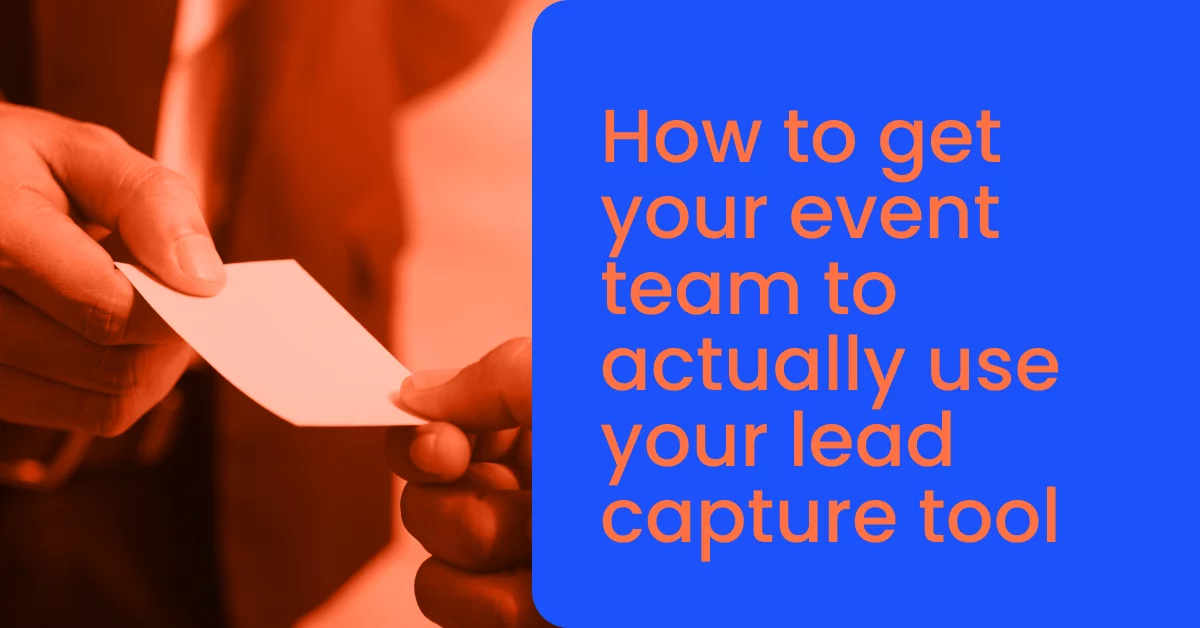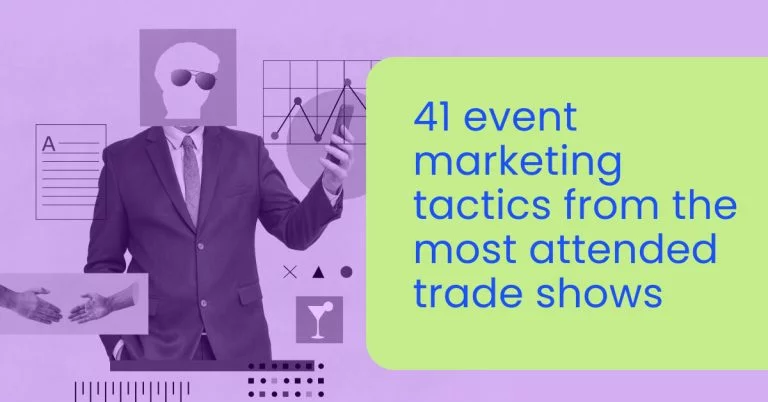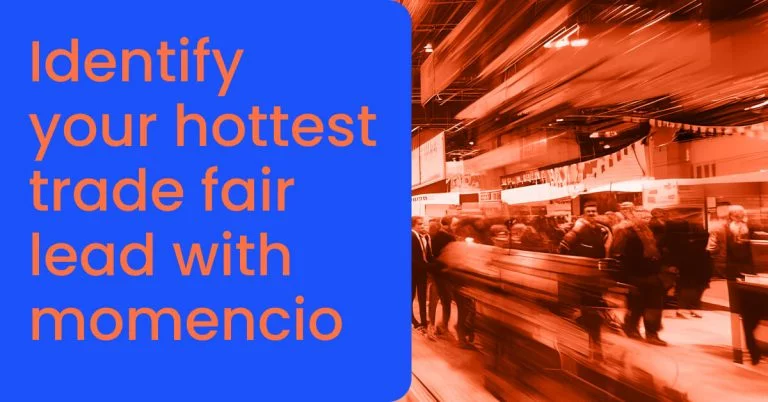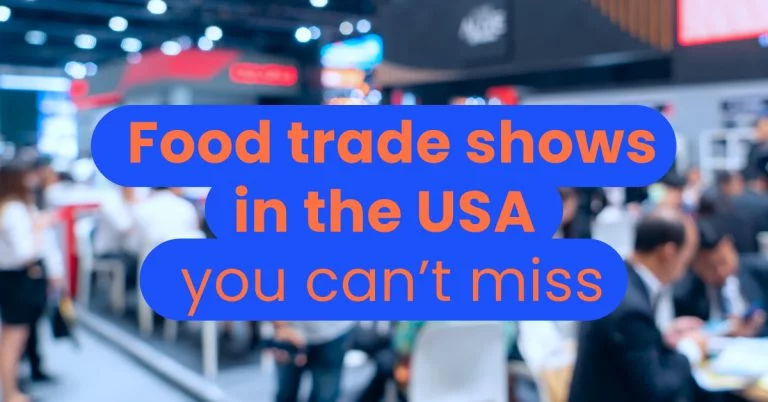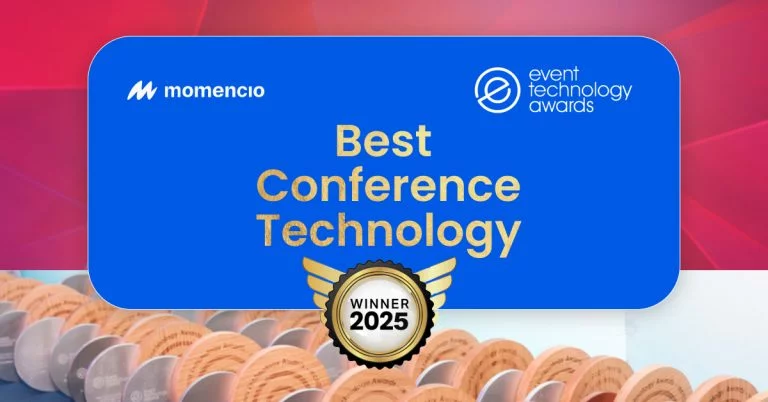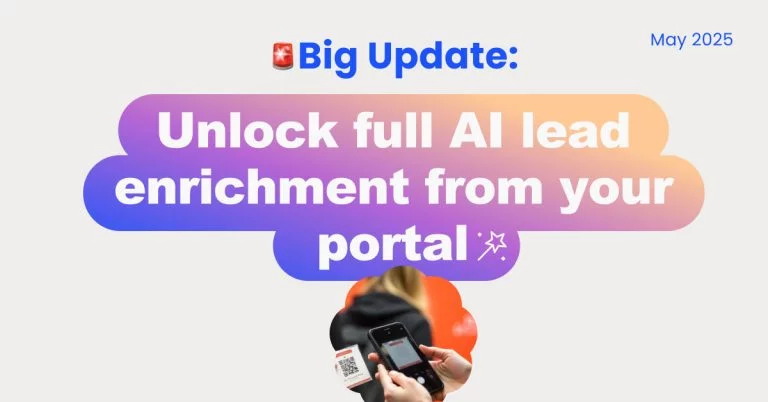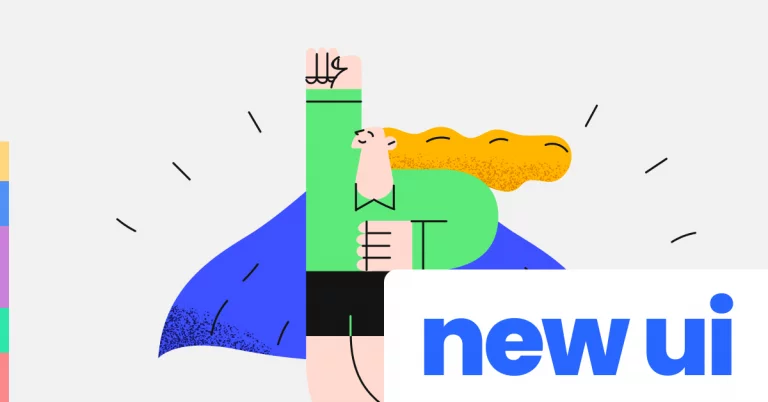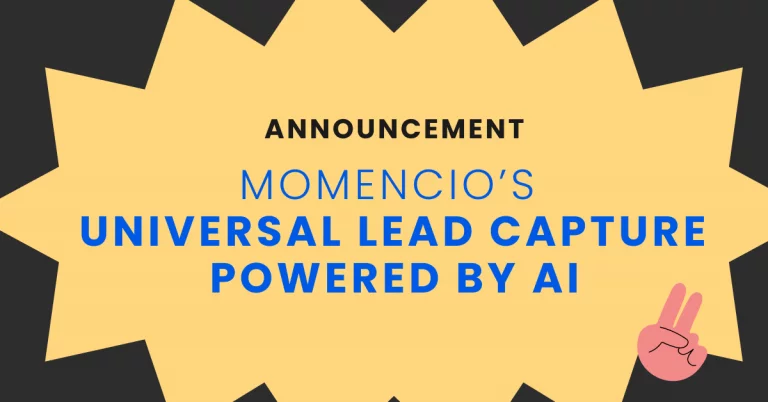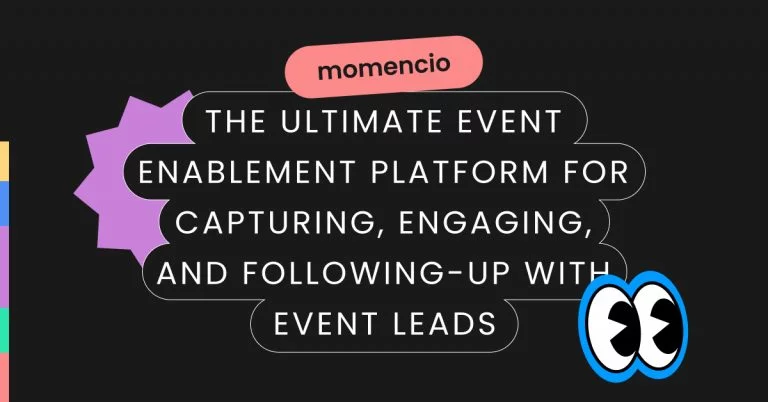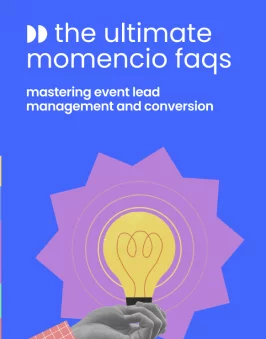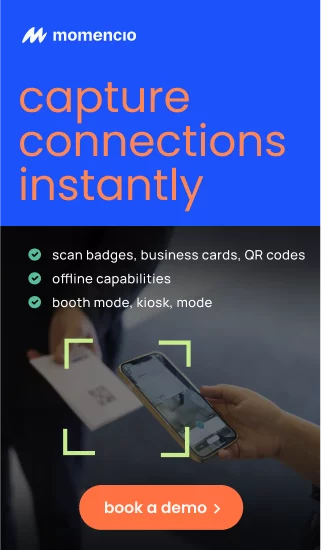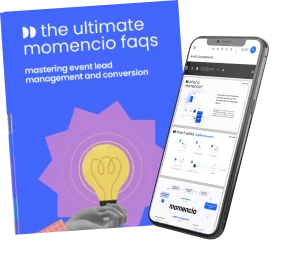It’s Monday morning after the big trade show. Your event marketing manager reviews the lead haul: 47 business cards rubber-banded together, a coffee-stained notepad with illegible scribbles, and a spreadsheet with half-completed rows. Meanwhile, the lead capture platform you invested thousands in? It captured exactly 12 leads.
Sound familiar?
You’re not alone. This scenario plays out at trade shows across the country every single week. Leadership invests in sophisticated lead capture tech promising streamlined data collection, instant CRM integration, and behavioral insights. Yet when the booth lights go up, field reps default to what they know: collecting business cards, jotting notes on brochures, and promising to “send that information over” later.
The disconnect isn’t just frustrating—it’s expensive. Lost leads mean lost revenue. Incomplete data makes ROI measurement impossible. Generic follow-ups that can’t be traced waste your marketing team’s time. And your executives? They’re left wondering why they can’t get clear answers about which trade shows actually drive pipeline.
#Didyouknow: Responding to a lead within 5 minutes rather than waiting makes conversion rates about 8× higher.
But here’s what most companies get wrong: They treat adoption as a training problem when it’s actually a trust problem. Field reps aren’t resisting because they’re stubborn or tech-illiterate. They’re resisting because they’re managing live conversations, running product demos, and fielding questions from prospects—all while trying to represent your brand flawlessly. Adding another task to that juggling act feels like setting them up to drop something important.
This article isn’t about forcing adoption. It’s about making your lead capture tool the obvious choice—the path of least resistance that actually makes your reps’ jobs easier, not harder. We’ll show you how to transform resistance into advocacy by understanding both sides of this challenge: the field reps who feel overwhelmed and the managers who need measurable results.
Part 1: Why field reps resist (and why they’re not wrong)
Before we solve the adoption problem, we need to understand it. When field reps push back against lead capture tools, they’re usually voicing one of these legitimate concerns:
“It’s extra work during chaos”
Picture your booth at 10 AM on Day 2 of a major trade show. Three prospects are waiting to talk. Someone’s asking where the bathroom is. Your colleague is mid-demo and needs you to grab the product spec sheet. The VP you’ve been hoping to meet just walked by.
Now add: Pull out your phone, open an app, scan a badge (or manually enter details if the scanner fails), select qualification criteria, add notes about the conversation, and choose relevant content to send.
From a rep’s perspective, this isn’t efficiency—it’s another plate to spin. They’re not wrong to feel this way. The trade show floor is controlled chaos, and any tool that doesn’t account for that reality will fail.
“Learning curves during crunch time”
Most reps get introduced to new lead capture tools days—or sometimes hours—before a major trade show. They’re already mentally preparing for the event: reviewing product updates, practicing demos, coordinating booth schedules. Now they need to learn a new system?
The anxiety is real. What if they forget how to use it under pressure? What if they look incompetent in front of a hot prospect while fumbling with technology? The safer bet feels like sticking with the familiar method, even if it’s flawed.
“Our current process works”
Here’s the thing about business cards and spreadsheets: They do work. Sort of. Eventually. With enough post-event data entry and follow-up effort.
Humans are naturally resistant to change, especially when the current process—however inefficient—produces some result. Field reps see the immediate effort required to adopt new technology, but they don’t immediately see the downstream benefits. That value realization gap creates resistance.
“What if the tech fails?”
Every field rep has a horror story about technology failing at the worst possible moment. WiFi that doesn’t work. Apps that crash. Syncing errors that lose data. The nightmare scenario of capturing 200 leads only to discover they never uploaded.
This isn’t paranoia—it’s learned caution. When the stakes are high and the window of opportunity is narrow, field reps gravitate toward methods they can physically control. A business card in hand feels more secure than data floating in the cloud.
The manager’s parallel challenge
While reps worry about individual adoption, managers face a coordination nightmare: How do you get a distributed team across multiple locations, managing multiple trade shows, to onboard simultaneously?
One team might be at a healthcare conference in Boston while another is at a tech expo in San Francisco. Training everyone consistently feels impossible. Ensuring everyone actually uses the tool? Even harder.
These concerns aren’t excuses—they’re real operational challenges that deserve thoughtful solutions. Dismissing them as resistance to progress misses the point entirely. The companies that achieve high adoption rates are the ones that take these concerns seriously and design their rollout strategy accordingly.
Part 2: The hidden cost of “just using business cards”
Now that we’ve validated the concerns, let’s examine what sticking with manual methods actually costs your organization.
The data entry time sink
Let’s do the math. After a trade show where your team collected 200 business cards:
- Each card takes 5-10 minutes to manually enter into your CRM (deciphering handwriting, finding company information, formatting correctly)
- That’s 16-33 hours of post-event data entry
- At a conservative $50/hour fully loaded cost, you’re spending $800-$1,650 in labor just entering data
- And that assumes your reps actually do it promptly instead of letting it pile up
This doesn’t count the opportunity cost of what else they could be doing during those hours: Following up with hot leads, preparing for the next event, or actually selling.
Data quality issues that multiply
Business cards and handwritten notes create a cascade of problems:
- Illegible handwriting leads to incorrect contact information
- Missing context about what the prospect was interested in
- No record of which product demo they watched or what content they requested
- Forgotten details about their timeline, budget, or decision-making authority
- Incomplete company information (industry, size, tech stack)
Each of these gaps means your sales team is going into follow-up conversations blind. They can’t personalize outreach. They can’t prioritize high-intent leads. They’re essentially making cold calls to people who already showed interest.
#Didyouknow: Exhibitors with digital lead-capture systems report 3x to 5× higher conversion rates than those relying on manual methods.
When Rajant Corporation switched to momencio’s lead capture platform, they discovered their previous manual process was creating 40-60% incomplete records. That’s nearly half their trade show investment producing unusable data.
Follow-up failures
Here’s what typically happens with manually collected leads:
Week 1 post-trade show: Reps are exhausted and buried in data entry. Follow-up is delayed.
Week 2: Generic email blast goes out: “Thanks for visiting our booth! Here’s our brochure.” No personalization. No context about their specific interests.
Week 3: The lead has already engaged with two competitors who followed up faster and more relevantly.
Without immediate, personalized follow-up, trade show leads go cold fast. Research shows that leads contacted within five minutes are 100 times more likely to convert than those contacted after 30 minutes. Yet most manual processes create week-long delays.
Zero behavioral intelligence
The most expensive cost is invisible: the complete absence of engagement data.
When you hand someone a brochure, you never know if they read it. When you promise to “send that case study over,” you don’t know if they opened it, or which section interested them most, or if they forwarded it to their boss.
This blind spot means:
- You can’t identify which leads are actively researching (hot) vs. passively collecting information (cold)
- You can’t adjust your follow-up strategy based on actual interest signals
- You can’t optimize which content resonates at trade shows
- You can’t coach reps on which approaches drive engagement
You’re essentially flying blind while your competitors are using instruments.
The manager’s dashboard problem
When executives ask “What’s our ROI on trade shows?”, managers using manual processes can only answer with vanity metrics:
- “We collected 200 business cards”
- “We had good booth traffic”
- “Reps said the conversations were quality”
What they can’t answer:
- Which leads are sales-ready right now?
- Which rep is most effective at qualifying prospects?
- Which product demos drive the most downstream engagement?
- What’s the actual pipeline value generated from this specific trade show?
Without real-time visibility, managers can’t coach their teams during the event. They can’t reallocate resources to high-traffic periods. They can’t identify struggling reps who need support. They’re managing in the dark.
The ROI black hole
Eventually, this all adds up to the ultimate problem: You can’t prove trade show value.
When the CFO questions your $50,000 trade show budget, you need to show pipeline generated, deals closed, and revenue attributed. Manual lead collection makes this nearly impossible. Leads get lost, attribution breaks down, and you’re left defending trade shows based on “gut feeling” rather than data.
Companies without robust lead capture and tracking typically see 40-60% of trade show leads never make it to sales. That’s not a follow-up problem—it’s a capture problem.
Part 3: The adoption framework that actually works
Now that we understand both the resistance and the cost of inaction, let’s build a framework that creates genuine adoption—not grudging compliance.
Phase 1: Pre-trade show—make success inevitable
The foundation for adoption is laid before anyone sets foot on the trade show floor.
-
Start with “Why,” not “How”
Most training sessions make this mistake: They jump straight into “Click here, then tap this button, then select this option.” Reps sit through the demo thinking, “Great, more steps to remember.”
Instead, start by showing them the post-trade show pain they’ll avoid:
“Remember last year when you spent three days after the show entering business cards into the CRM? And then realized you couldn’t remember what half those people were interested in? And then the follow-up took another week, by which time most leads had gone cold?”
Then show them the alternative:
“With momencio, every lead is automatically enriched and in the CRM before you leave the booth. You can send personalized content while the conversation is fresh. And you’ll know exactly which leads are engaging with your follow-up materials before you even pick up the phone.”
When Rajant Corporation implemented momencio, they made this the centerpiece of their rollout. They shared specific examples of how the previous manual process had cost them deals. Then they showed how momencio’s Livemicrosites enabled their reps to send personalized, trackable content instantly—no more promising to “email it later” and forgetting.
The result? Smoother follow-ups, better lead quality, and faster close times. But more importantly, reps bought in because they understood how it solved their problems, not just management’s.
Connect the tool to their success metrics:
- Sales reps: “You’ll know which leads are hot and ready for your call—no more wasting time on tire-kickers”
- Field marketers: “You’ll have engagement data to prove which content works best”
- Everyone: “You’ll spend less time on data entry and more time actually selling”
-
Leverage professional onboarding
Here’s where you remove the learning curve anxiety entirely.
Your field team won’t be figuring this out alone at 6 AM on the trade show floor. momencio’s customer onboarding program is specifically designed for tech-averse teams who need to be confident and competent before the event starts.
This isn’t a “here’s a 30-minute webinar, good luck” approach. Professional onboarding means:
- Hands-on training sessions tailored to your team’s specific trade show workflow
- Practice scenarios that mirror what they’ll encounter on the floor
- Different training formats for different learning styles (visual, hands-on, reference documentation)
- Dedicated support during the critical first trade show
- Follow-up sessions to address questions that emerge from real-world use
The message to your team should be clear: “The learning curve you’re worried about? We’ve already solved for it. By the time you’re at the trade show, this will feel second nature.”
When reps know they’ll have comprehensive support, resistance melts. The fear isn’t really about learning something new—it’s about being set up to fail in a high-pressure environment. Professional onboarding eliminates that risk.
-
Create champions, not mandates
Don’t try to convert everyone at once. Instead, identify 2-3 naturally tech-comfortable reps and make them your early adopters.
Give them early access to momencio before the wider rollout. Let them experiment with features. Encourage them to discover benefits organically rather than being told what to appreciate.
These champions become your most powerful adoption tool—because their testimonials carry more weight than any management mandate:
“I was skeptical too, but after using it at the Boston trade show, there’s no way I’m going back to business cards. Being able to see which leads are actually watching our demo videos? That’s a game-changer for prioritizing follow-up.”
Peer validation from someone who was initially skeptical is exponentially more persuasive than management directive.
-
Simplify to the essentials
One of the biggest adoption mistakes is overwhelming reps with every feature on Day 1.
momencio offers powerful capabilities: AI EdgeCapture for data enrichment, Intellistream for real-time lead activity tracking, AI Intellisense for behavioral intelligence, event dashboards for performance visualization, interactive games, and more.
But on Day 1? Start with just three things:
- Capture the lead (badge scan or manual entry)
- Pick relevant content from your digital assets library
- Send a personalized Livemicrosite
That’s it. Get reps comfortable with this basic workflow first.
Once they see the value—leads receiving tailored content immediately, engagement notifications coming in, no post-trade show data entry debt—then layer in the advanced features:
- “Want to see which leads are actively reviewing your content? Let me show you Intellistream…”
- “Curious which of your leads are most engaged? Check out the momencio score…”
- “Want to see how you’re performing compared to the team? Here’s the event dashboard…”
Progressive disclosure prevents overwhelm and creates natural moments for feature discovery driven by curiosity rather than obligation.
Phase 2: During trade show—remove every friction point
The rubber meets the road when the trade show opens. This is where adoption lives or dies.
-
Solve the “what if it breaks” fear
The nightmare scenario every rep worries about: The WiFi goes down, the app crashes, and 200 leads vanish into the digital ether.
momencio eliminates this fear with offline functionality. When connectivity is spotty or nonexistent, the event app continues logging leads locally. The moment the device reconnects, everything automatically syncs with your integrated CRM. No data loss. No manual recovery.
This isn’t a theoretical backup plan—it’s built into the core functionality. Make sure your team knows this before the trade show starts. Run a demonstration where you deliberately turn off WiFi, capture a few test leads, then reconnect and watch them sync.
Additionally, momencio offers multiple capture methods precisely because trade shows are unpredictable:
- Badge scanning when you have reliable scanners
- Manual entry when badges are unreadable or scanning isn’t possible
- Business card photo capture as a backup option
Whatever works in the moment, you’re covered. This flexibility is the opposite of fragile technology—it adapts to reality rather than demanding reality adapt to it.
Communicate the backup plan clearly, but emphasize they won’t need it. When reps see that the tool is designed for worst-case scenarios, they trust it in normal scenarios.
-
Make it faster than the old way
Speed is everything on a crowded trade show floor. If your lead capture tool is slower than collecting a business card, adoption will fail.
Here’s the reality check:
- Business card collection: Hand them a card, they hand you theirs, you write notes on it or in your notepad = 1-2 minutes
- momencio badge scan: Scan their badge, system auto-enriches with company data via AI EdgeCapture = 5 seconds
That’s not hyperbole. A badge scan is genuinely faster than physical card exchange, and infinitely faster than the post-trade show data entry that manual collection requires.
But speed isn’t just about capture—it’s about the entire workflow:
Old way:
- Collect business card (1 min)
- Write notes about conversation (1 min)
- Post-trade show: Decipher handwriting and enter into CRM (5-10 min per lead)
- Find relevant content to send (5 min)
- Compose email and attach materials (5 min)
- Cross fingers and hope they engage (unknown results)
Total time per lead: 17-22 minutes, with delayed follow-up
momencio way:
- Scan badge—AI EdgeCapture automatically enriches with company info, fills missing gaps, maintains clean records (5 seconds)
- While still talking with the prospect, tap a few relevant content pieces from your digital assets library (15 seconds)
- Send personalized Livemicrosite via email right from the booth (5 seconds)
- Lead receives tailored content in their inbox while conversation is still fresh
- Intellistream shows you their engagement in real-time
- AI Intellisense tells you which leads are sales-ready and what to do next
Total time per lead: 25 seconds, with instant follow-up and behavioral intelligence
When you frame it this way, the “extra work” narrative flips entirely. The tool isn’t adding work—it’s eliminating hours of future work while improving results.
-
Provide real-time value they can SEE
Abstract future benefits don’t drive adoption. Immediate, tangible value does.
This is where momencio’s real-time capabilities become your secret weapon:
During booth downtime, reps can open Intellistream and see:
- “The VP I talked to this morning already watched our demo video twice and downloaded the pricing sheet”
- “That prospect from the 2 PM conversation just spent 8 minutes on our case studies page”
- “The procurement manager hasn’t opened the email yet—I should follow up differently”
These aren’t vanity metrics—they’re actionable intelligence that makes reps feel like they have superpowers. They’re no longer guessing who’s interested. They know.
The momencio score provides an at-a-glance engagement indicator. Every action—click, scroll, download, video watch time—gets logged and weighted. Reps can instantly see which leads are hot (85+ score) and which are lukewarm (40-60 score), allowing them to adjust their follow-up strategy in real-time.
AI Intellisense takes this further by functioning as a behavioral intelligence engine. It doesn’t just show you data—it interprets it: “This lead is ready for a sales call,” “This lead needs more nurturing content,” “This lead hasn’t engaged—try a different approach.”
The event dashboard adds a layer of healthy competition. Reps can see:
- Their lead count versus teammates
- Their average engagement score
- Which types of content they’re sharing most successfully
This isn’t about shaming low performers—it’s about creating visibility that drives motivation. When Sarah sees she’s captured 15 leads before lunch and they’re highly engaged, she feels accomplished. When Mike sees Sarah’s numbers, he gets inspired to step up his game.
For reps, this real-time feedback loop is addictive. They start checking Intellistream obsessively because it tells them something valuable: who to prioritize next.
-
Manager’s role: Be present and supportive
Manager behavior during the trade show sets the tone for adoption success or failure.
First hour of Day 1 is critical. Don’t sit in the back office catching up on email. Float the booth. Watch how reps are using the tool. Troubleshoot blockers immediately. Offer encouragement.
If you see a rep struggling with the app, don’t wait for them to ask for help. Jump in: “Hey, looks like you’re having trouble scanning that badge—let me show you the manual entry option.”
Use the event dashboard not as a surveillance tool but as a coaching opportunity. If you notice a rep hasn’t captured any leads in the first two hours, that’s not a time to criticize—it’s a time to help. Maybe they’re uncomfortable approaching people. Maybe they’re spending too long in demos. Maybe they’re just having a slow morning. Your job is to support, not scold.
Celebrate early wins publicly: “Sarah just captured 15 leads before lunch and already has three prospects reviewing content on their Livemicrosites. Awesome job, Sarah!”
This accomplishes three things:
- Recognizes good performance
- Shows the tool is working as promised
- Creates social proof that encourages others
When managers are visibly invested in the tool’s success and supportive of the team, adoption follows naturally.
Phase 3: Gamification & incentives (the secret weapon)
Human beings are competitive and motivated by recognition. Use this.
-
Make adoption competitive and fun
Create a leaderboard visible on the event dashboard with real-time updates:
- Most leads captured
- Most content shared via Livemicrosites
- Highest average engagement scores
- Most leads with 70+ momencio scores
Update it throughout the day. Make it visible. Let friendly competition drive energy.
Offer prizes that matter:
- Best performer gets dinner at a nice restaurant (or gift card if remote team)
- Top three get extra PTO day
- Winner gets public recognition in company all-hands meeting
- Team that performs best across multiple trade shows gets a team outing
The investment in prizes is minimal compared to the ROI of full team adoption.
-
Quality over quantity metrics
Important caveat: Don’t reward lead volume alone. That incentivizes badge-scanning spam—running around the trade show floor scanning everyone indiscriminately without actual qualification.
Instead, reward quality indicators:
- Most personalized Livemicrosites created: Shows reps are thoughtfully selecting relevant content
- Highest average engagement scores: Indicates they’re capturing genuinely interested prospects
- Most leads with sustained engagement: Rewards those whose leads keep coming back to review content
When Rajant implemented momencio, they noticed reps who took time to curate content for each lead’s specific interests generated significantly higher engagement rates. Those reps’ leads were more likely to convert because the follow-up was genuinely relevant.
Reward that behavior, not just volume.
-
In-app engagement tools
Here’s a brilliant adoption hack: momencio’s interactive games and booth experiences don’t just engage prospects—they create natural usage patterns for reps.
When you have an interactive quiz or assessment running at your booth, reps see immediate engagement data flowing in. They watch prospects complete activities, see their scores, view their qualification answers. The tool becomes fun rather than burdensome.
Gamification for leads creates natural usage for reps. They’re not “forcing themselves” to use the technology—they’re engaged with it because it’s actively helping them understand prospect interest in real-time.
Plus, these experiences collect qualification data naturally without feeling like an interrogation. A prospect completing a “What’s Your Digital Transformation Maturity?” quiz reveals far more about their needs than asking them to fill out a form.
Phase 4: Post-trade show—prove the value
Adoption becomes permanent when reps experience the post-trade show benefit.
-
Show them what they couldn’t see before
Schedule a team debrief within 48 hours of the trade show ending. Pull up Intellistream and walk through real examples:
“See this VP from the pharmaceutical company? They’ve reviewed your pricing page six times since the trade show. They downloaded the enterprise deployment guide and forwarded your Livemicrosite to two colleagues. That’s a buying signal—you should call them today.”
“This lead seemed really interested at the booth but hasn’t opened your follow-up email at all. Different approach needed there—maybe try a phone call with a different angle.”
Compare results:
- Generic email blast approach: 18% open rate, 3% click rate, no visibility into who’s actually interested
- Personalized Livemicrosite approach: 67% open rate, 43% average engagement with content, real-time visibility into who’s hot
When reps see leads with 70+ momencio scores converting 3x faster than those with generic follow-up, the value becomes undeniable.
-
Make follow-up ridiculously easy
The ultimate adoption moment comes when reps realize they have zero data entry debt.
Old way: Three days of post-trade show drudgery entering business cards, trying to remember conversation context, manually finding and sending content.
momencio way: Everything’s already in the CRM via auto-sync. Livemicrosites were built and sent from the booth. All they need to do is check AI Intellisense to see who to prioritize first.
AI Intellisense surfaces the sales-ready leads: “These 12 leads are showing high engagement and are ready for outreach NOW. Here’s the talking point based on what content they’ve engaged with most.”
This isn’t just easier—it’s strategically smarter. Reps are calling prospects at the exact right moment with the exact right message based on actual behavioral data.
-
Celebrate and reinforce
End the debrief with recognition:
“Because we captured complete, enriched data during the trade show, we’re already seeing qualified pipeline from this event. Sarah’s leads are particularly engaged—three already moved to opportunity stage. Mike’s personalized Livemicrosites are seeing 82% average engagement rates. This is what success looks like.”
Then ask the group: “What would going back to business cards feel like now?”
The answer, inevitably: “Terrible. Like being blindfolded.”
That’s when you know adoption is complete. They’re not using the tool because they have to—they’re using it because anything else feels like a handicap.
Part 4: Addressing the collective resistance challenge
Individual rep adoption is one thing. Getting an entire organization—across multiple locations, multiple trade shows, multiple teams—to adopt consistently is the real challenge.
When it’s not one rep—it’s the culture
If adoption is struggling across the board, the problem isn’t individual resistance—it’s organizational culture.
-
Diagnose the root cause
Is it poor past experiences? Many organizations have inflicted “mandatory” tools on their teams before, only to have those tools fail spectacularly. Buggy apps. Promised features that never materialized. Vendors who disappeared after the sale.
If your team has been burned before, they’re approaching your new lead capture tool with justified skepticism. Acknowledge this: “I know we’ve asked you to adopt tools before that didn’t work out. Here’s why this is different…”
Is it lack of leadership buy-in? If executives aren’t visibly using the tool (or at least reviewing its outputs), reps pick up on that signal: “Management says this is important, but they’re not actually checking if we use it. So it’s not really important.”
Leadership must be visibly invested. That means:
- Executives review event dashboards regularly
- Leaders ask about momencio scores in pipeline meetings
- Management references Intellistream data in strategy discussions
When leadership demonstrates the tool matters, teams follow.
Is it unclear consequences? If non-adoption has no consequences, adoption remains optional. Many organizations make this mistake: They introduce a new tool, some reps use it, some don’t, and nothing happens to either group.
This signals the tool isn’t actually required. Be clear: “Going forward, trade show lead capture happens through momencio. This is how we measure event ROI, and it’s part of your performance expectations.”
-
Create organizational alignment
Remove the old option. As long as manual methods are available, some reps will default to them. Make the new way the only way:
- No more business card reimbursement
- No more post-trade show spreadsheet templates
- CRM updates from trade shows must come through momencio integration
This isn’t about being draconian—it’s about removing the path of least resistance that leads to bad outcomes.
Leadership must model the behavior. If your VP of Sales attends a trade show, they use momencio too. If your CMO visits the booth, they capture leads through the platform. No exceptions for seniority.
When junior reps see executives using the tool, it sends a powerful message: This isn’t beneath anyone.
Make tool usage part of performance expectations. Include trade show lead capture quality in performance reviews:
- “Consistently captures complete lead data with relevant content personalization”
- “Achieves average engagement scores above X%”
- “Follows up with high-scoring leads within 24 hours”
When it’s part of how performance is measured, it gets done.
-
Multi-location, multi-event rollout strategy
You can’t flip a switch and have 50 field reps across 10 locations adopt simultaneously. That’s a recipe for chaos.
Pilot with one high-performing team/event first. Choose a team that’s naturally more open to change and a trade show that’s important but not your absolute highest-stakes event.
Give this pilot team the full treatment:
- Intensive onboarding
- Manager presence during the trade show
- Real-time support
- Post-event detailed analysis
Document their success with specific metrics:
- “Northeast team captured 340 leads with 98% complete data enrichment”
- “Average follow-up time decreased from 5 days to 4 hours”
- “Leads with personalized Livemicrosites showed 3.2x higher engagement”
- “Sales cycle shortened by 18 days for momencio-captured leads”
Use that as an internal case study. When rolling out to the next region, lead with: “The Northeast team just completed their first trade show with momencio. Here’s what they achieved…”
Peer success stories from within your own organization are more persuasive than any external case study.
Provide regional champions. The Northeast team’s top performer becomes the mentor for the Southeast rollout. They’ve “been there,” they understand the concerns, and they can offer practical tips that outsiders can’t.
This creates a cascading adoption model where each successful wave supports the next.
-
Continuous improvement loop
Adoption isn’t a one-time event—it’s an ongoing process.
Gather feedback after each trade show: What worked smoothly? What was clunky? What feature would have helped that didn’t exist?
Create a simple post-event survey:
- On a scale of 1-10, how easy was lead capture?
- What friction points did you encounter?
- What would have made your job easier?
- Would you recommend momencio to a colleague?
Surface common pain points. If five reps independently mention that manual entry is slow for international contacts, that’s actionable feedback. If multiple people wish they could customize Livemicrosite templates faster, that’s a feature request worth prioritizing.
Show reps their feedback matters. Close the loop: “Several of you mentioned wanting quicker access to product videos during conversations. We worked with momencio to add that to your quick-access library. Try it at the next trade show.”
When teams see their input shaping the tool, they become invested in its success. It’s not “management’s tool they’re forced to use”—it’s “our tool that we’re refining together.”
This continuous improvement mindset transforms adoption from a one-time hurdle into an ongoing partnership.
Part 5: The momencio advantage—built for adoption
Let’s bring this home by highlighting why momencio specifically solves for the adoption challenges we’ve discussed.
Flexibility that adapts to reality
Field reps resist tools that force them into rigid workflows. momencio offers multiple lead capture methods—badge scanning, manual entry, business card photos—because trade show floors are unpredictable.
The tool adapts to them, not the other way around. This flexibility is the opposite of “one more thing to remember”—it’s “whatever works in your situation.”
Intelligence that makes reps look smarter
Nobody wants to work harder. Everyone wants to work smarter.
AI EdgeCapture automatically enriches lead information without requiring expensive event API integrations. It fills in missing gaps—company size, industry, tech stack—so reps maintain clean, complete records without manual research.
AI Intellisense functions as a behavioral intelligence engine that reveals who’s ready to buy, who needs more nurturing, and what to do next. Reps don’t need to interpret data—the system interprets it for them and serves up actionable recommendations.
momencio scoring distills complex engagement patterns into a simple number. A lead with an 85 score is hot. A lead with a 45 score needs more content. It’s that straightforward.
These intelligence layers don’t add work—they eliminate guesswork. Reps feel more confident because they have information their competitors don’t.
Personalization at scale without manual effort
Here’s the magic of Livemicrosites: They make every follow-up feel custom without requiring custom work.
Instead of spending 20 minutes crafting a personalized email with attachments, reps tap 3-4 relevant pieces from their digital assets library—case studies, videos, product sheets, demos—and momencio instantly builds a branded microsite tailored to that lead’s interests.
The lead receives a link to their personal hub with exactly the content relevant to their needs. It feels highly personalized because it is—but the rep didn’t spend hours creating it.
This is the holy grail: personalization that scales. One-to-one engagement without one-to-one effort.
Visibility that drives action
Intellistream provides real-time lead activity tracking that’s actually useful. Reps see:
- Which leads are actively reviewing content (hot signals)
- Which specific pages they’re spending time on (interest areas)
- Whether they’re forwarding materials to colleagues (buying committee engagement)
- When they’re engaging (timing for outreach)
Every action—click, scroll, download, video watch time—gets logged. This isn’t surveillance; it’s intelligence.
For managers, event dashboards provide real-time visibility into:
- Lead flow throughout the day
- Rep performance and activity levels
- Content engagement patterns
- Booth traffic trends
This allows for in-the-moment coaching and resource allocation. If booth traffic spikes at 2 PM, you can redirect team members. If one rep is struggling, you can support them before the day ends.
Reliability when stakes are high
The offline functionality solves the “what if the tech fails” fear. Leads get logged locally and auto-sync when connectivity returns. No data loss. No manual recovery.
Auto-sync with integrated CRMs means zero post-trade show data entry. Everything flows automatically to Salesforce, HubSpot, or whatever system you use.
This reliability removes the anxiety that kills adoption.
Engagement tools that feel like value-add
Interactive games and booth experiences don’t feel like work—they feel like tools that make the booth more engaging.
Presentations and interactive content replace untraceable paper brochures with dynamic, measurable materials. Reps can share immersive videos, dynamic presentations, and interactive demos—all trackable through Intellistream.
This isn’t just “capture leads better”—it’s “run a better booth experience.” That shift in framing matters. Reps aren’t adopting a data collection tool; they’re adopting a competitive advantage.
The Rajant story
When Rajant Corporation implemented momencio, they faced the exact challenges we’ve discussed: field reps accustomed to manual processes, concerns about learning curves, and the need to prove trade show ROI.
The results after adoption:
- Dramatically improved lead data quality (reducing incomplete records from 40-60% to near-zero)
- Faster follow-up times with personalized content delivery
- Real-time visibility into lead engagement enabling smarter sales prioritization
- Measurable increase in trade show-sourced pipeline
But perhaps most tellingly: Their reps became advocates. The team that was initially skeptical now can’t imagine returning to business cards and spreadsheets.
That’s the ultimate measure of successful adoption—when the tool becomes indispensable.
Conclusion: From resistance to advocacy
The goal isn’t to force your field team to use a lead capture tool. The goal is to create believers.
When reps see leads engage with their personalized Livemicrosites in real-time, they experience a shift: “I’m not just collecting contacts—I’m driving measurable interest.”
When managers review event dashboards showing clean data, complete lead intelligence, and measurable ROI, they become evangelists: “This is how we prove trade show value to the executive team.”
The transformation from “I have to use this” to “I can’t imagine not using this” doesn’t happen through mandate. It happens through design—designing an onboarding process that removes anxiety, a workflow that’s genuinely faster than the alternative, real-time value that reps can see and feel, and post-trade show benefits that make the old way unthinkable.
The best lead capture tool is the one that makes your team’s job easier, not harder. It’s the one that gives reps superpowers they didn’t have before: knowing which leads are hot, sending personalized content instantly, following up with precision instead of guesswork.
That’s what adoption looks like. Not compliance. Not grudging acceptance. But genuine enthusiasm from a team that’s been given better tools to do their job.
momencio is built for this reality. It’s designed for tech-averse field teams managing chaos on trade show floors. It’s built for managers who need visibility and measurable results. And it’s proven by organizations like Rajant who’ve made the journey from resistance to advocacy.
Ready to turn your resistant team into believers?
See how momencio can transform your trade show lead capture from a data entry problem into a competitive advantage.
Request a demo to experience the difference.
Want to see real results? Check out how Rajant Corporation achieved measurable ROI with momencio’s platform.
The next time you’re standing in your booth with business cards rubber-banded together while your lead capture platform sits unused, remember: You don’t have a technology problem. You have an adoption problem. And adoption problems have solutions.
